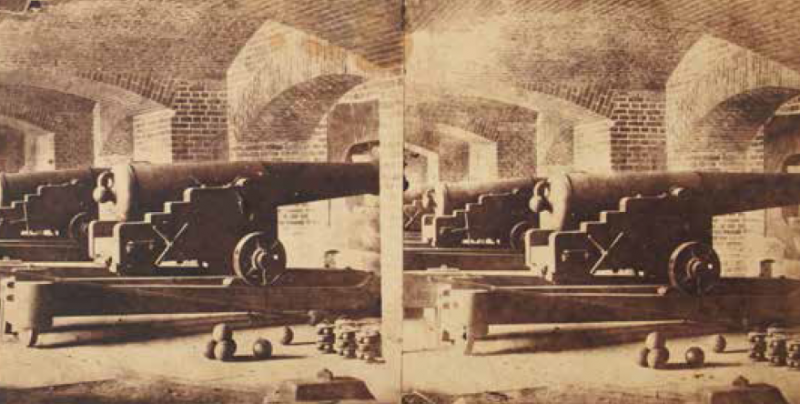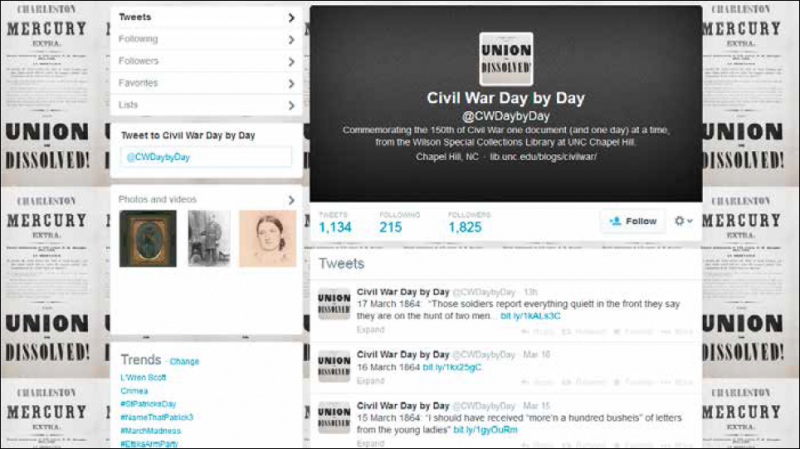
Biff Hollingsworth of the University of North Carolina at Chapel Hill has received the 2014 CRL Primary Source Award for Access, as the key creator of the innovative “Civil War Day by Day” project. The award recognizes people and projects that promote innovative use of primary source materials and ways to make them more accessible.
The “Civil War Day by Day” project (CWDD) features an innovative daily blog, online postings, and library exhibitions that focus on the lives of soldiers, slaves, and families and how they experienced the war, rather than on the traditional exhibition narrative based on military strategies, troop movements, and famous battles and commanders.
The online blog was launched on April 12, 2011, on the 150th anniversary of the outbreak of the Civil War at Fort Sumter, South Carolina, and will continue through April 9, 2015, the 150th anniversary of General Robert E. Lee’s surrender.
To establish a virtual connection between the experiences then and now, the project chronicles on a day-by-day basis the experiences of everyday people using datespecific, primary source materials, such as letters, pamphlets, books, photographs, telegrams, diaries, and sheet music, displayed on the same day 150 years later. The intent, Hollingsworth noted, was “to provide a sense of how the war was experienced by people living through it, who didn’t know how it would end, or what might happen to them and their loved ones.”
The resources for each day’s post are drawn from the vast holdings of the University of North Carolina’s Louis Round Wilson Special Collections Library, the Southern Historical Collection, North Carolina Collection, Rare Book Collection, and the University Archives and Records Management Services.
The project allows visitors to interact with the collections and primary source materials in new and interesting ways. For instance, on a post for the date August 17, 1861 (posted on August 17, 2011), a commenter wrote, “I am the great granddaughter of Susie Mallett and her namesake. I am the granddaughter of her son, Owen Davis Holmes. As a local history librarian in Indiana I have been working on digital projects . . . [and] was delighted to discover this family letter.” Other comments included a spirited debate on whether a post on “stereo views of Fort Sumter,” dated April 17, 1861, were staged at a later date, since the scene seems too tidy for a photo taken a few days after a fierce battle.
In addition to shifting the exhibition’s historical perspective from the traditional military viewpoint to a more personal human focus, the project documents the reach and impact of slavery as the war marched on. For example, after General James Johnston Pettigrew was mortally wounded at Gettysburg, his family spent a long time discussing the fate of Peter, his “body servant” (slave) in their letters. The project also features letters about the movement of enslaved people from place to place as military control of various locations changed, as well as many letters written by enslaved persons, such as a letter dated March 25, 1863 in which a slave requests permission to marry.
The boundaries of the project expand to include lectures in the library, such as one by University of Missouri professor LeeAnn Whites titled “Battle for the Home Front: Revisiting the Role of Women in the Civil War.” Under the Classroom Resources menu, the project provides guidelines for using primary source materials from the CWDD in the classroom.
The CWDD project and its social media outreach efforts on Facebook (395 followers and growing), Twitter (1,754 followers and growing), and a YouTube video (viewed more than 2,300 times) have improved access and driven interest in the project for individuals and organizations who were unaware of the library’s wealth of material on the Civil War.
